Text
Plant-Based vs Animal-Based
A plant-based diet consists mainly of whole grains, legumes, vegetables, and fruits, and doesn’t rely on animal protein as its main source of nutrients. According to the National Kidney Foundation, this may differ from a Vegan diet because a plant-based diet may include things like eggs, milk, and honey, whereas a Vegan diet tends to avoid all products derived from animals and extends into the realm of a lifestyle philosophy. 1
Comparison with an animal-based diet
People choose to adopt a plant-based diet mainly for its health benefits but may choose to do so for ethical and environmental reasons as well. We’ll look at a comparison below:
Plant-Based:
Higher in Fibre
Little to no saturated fats
Decreases the risk of heart disease, obesity, and stroke
Uses less resources to produce food
Does not harm or mistreat animals
Costs less to produce a Meal
Animal-Based:
Little to no fibre
Higher in Saturated fats
Increases the risk of heart disease, obesity, and stroke
Uses large masses of land and resources to produce food; produces more environmentally harmful emissions
Causes harm to animals
The cost of buying more animal protein is significantly higher than purchasing vegetables and whole grains 2
-----------------------------------------------------------------
I was first introduced to the concept of Veganism through an article I read in Source Magazine in the early 2000s. One of my favourite rappers spoke about his long-term veganism and held conspiracy theories about the meat industry injecting addictive substances into meat that made it more difficult than normal to give up meat. I was young and impressionable then and wanted to see if this was true. So I gave it a try for a couple months. That stretched into a year, afterwhich, I started eating animal products again.
Now, both my Fiancé’s parents are active Vegans and make a great case for a plant-based lifestyle. I’ve experimented with a vegan diet, and can vouch for the benefits it has in terms of increased energy levels and a general sense of well-being.
I did find I was buying food more often on a plant-based diet because my body digested meals easier.
One of the negatives that come with a plant-based diet are the reduced menu options at most restaurants. You’re handed a menu of 10 items, out of which 3-4 will be plant-based options, if you’re lucky.
I’ve had to come up with dinners for special occasions for my in-laws, which has forced me to create delicious plant-based substitutes where meat and dairy would normally be used (cashew cream in place of dairy, mushrooms/beets/tofu in place of meat). I’ve always wanted to create a restaurant menu with about 8-10 items, each with a vegan equivalent. This gives all people a chance to choose something from the menu without feeling excluded and promotes a higher chance of people choosing a healthier option.
One of my favourite recipes during the winter is a warm comforting chilli.
I like to incorporate every scrap vegetable I have in my fridge, in this instance, I happened to have some beets left over from the night before.
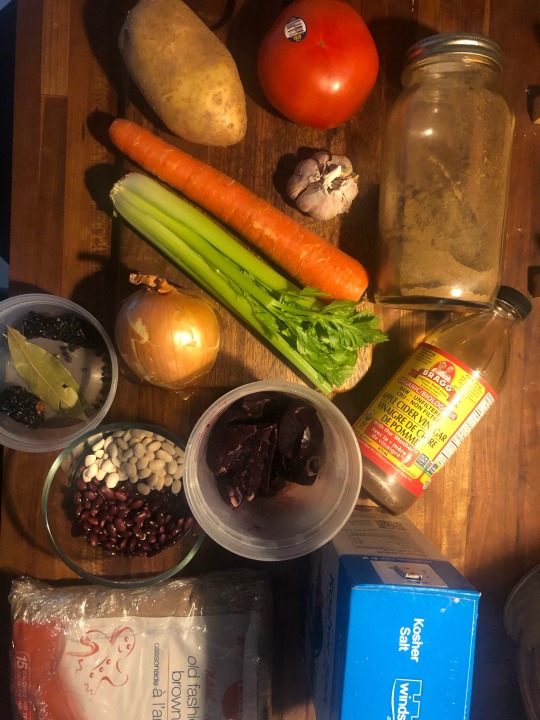
Ingredients
100g Red Kidney Beans100g
White navy beans (optional)
1 medium yellow onion
1 celery stalk
1 carrot
1 tomato
2 bay leaves
5 cloves garlic
1 russet potato
2 tbsp apple cider vinegar
3 tbsp cumin
3-4 Morena chilies, or chipotle peppers
¼ cup brown sugar
½ can tomato paste
3 tbsp Olive oil
6L water
Kosher salt and black pepper to taste
1 deep stock pot
1 wooden spoon
Method
You’ll need to soak your beans overnight, so get them into a bowl and cover with cold water. Let them sit at room temp for at least 8 hours, then drain when ready to cook.
Deseed your chilies and puree them in a food processor with 5 garlic cloves and some water. Set aside.
Preheat stock pot with olive oil on medium high heat. Dice onion, carrot, celery, tomato and potato, and add them to the stock pot, stirring with a wooden spoon. Once your vegetables start to caramelize, add your cumin and your garlic and chili puree and mix in. Season your vegetables with a few pinches of salt and some cracks of black pepper. Add tomato paste and brown sugar to the mix and allow to cook down 3-5 minutes. Deglaze the pot with apple cider vinegar, being sure to scrape all the bits from the bottom.
Add drained beans and cover the vegetables and beans with water. Add bay leaves. Bring up to a boil then reduce to a simmer. Allow your chili to cook at a slight simmer until the liquid has reduced and thickened, and your beans are tender. This should take an hour to two hours. Stir every 15 minutes and taste for seasoning.
Once cooked, feel free to serve in a large bowl with whatever garnish you have (eg. Cilantro, chives, an apple slice).
-----------------------------------------------------------------
This is a one-pot recipe that involves slow-cooking all your ingredients over a long period of time. Soaking beans overnight will help them become tender quicker, but it means a lot of patience. I like to get a pot on in the early afternoon and serve it for dinner.
Sourcing ingredients for this dish is not difficult as it seeks to use up leftover vegetables. A 1kg bag of dried red kidney beans costs about $2.99 and lasts a long time. I find the addition of potatoes adds starch and thickens the liquid quite nicely giving the chili a desirable texture without added flour as a thickener. In the future, I would experiment with a ground nut or seed as a garnish to add a crunch to this dish, and would serve it with fresh bread or rice for a complete meal.
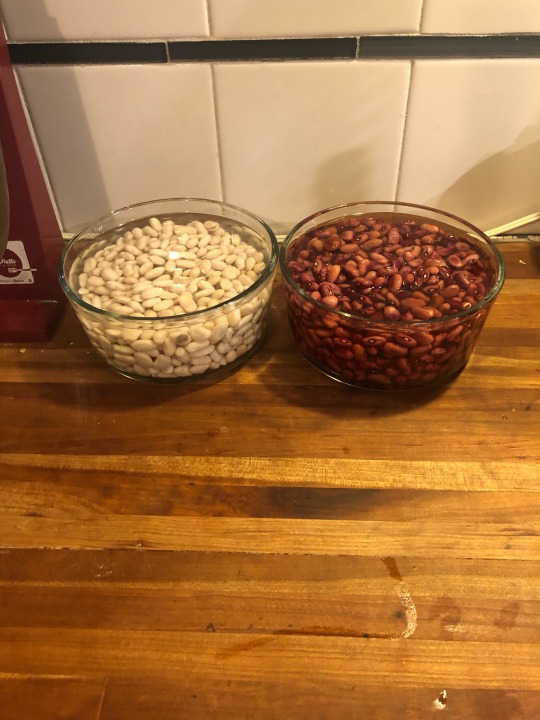
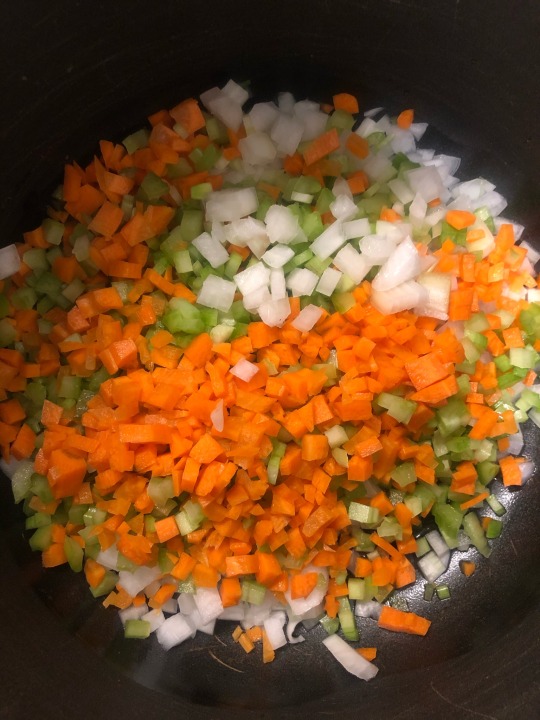
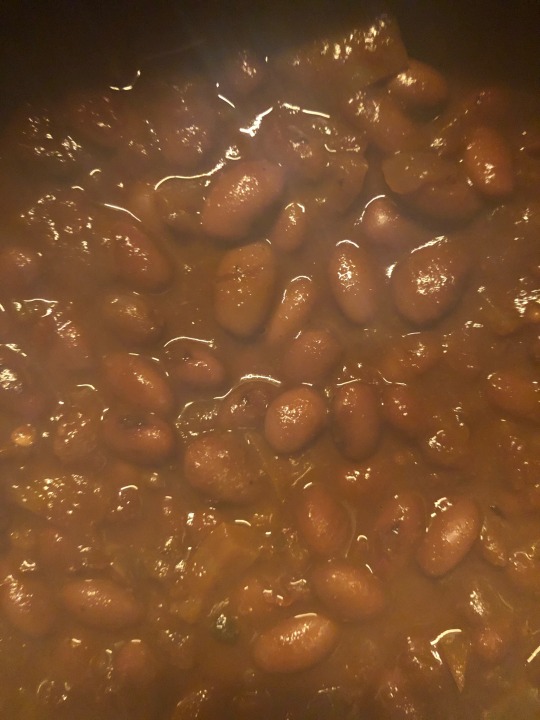
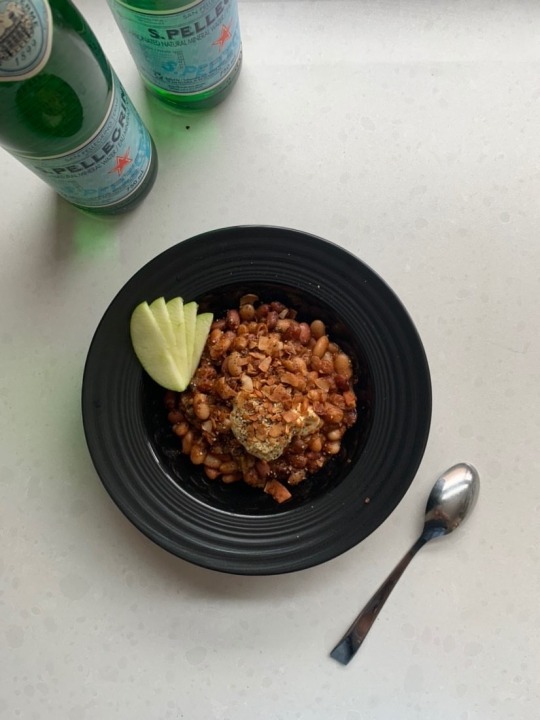
1. “Plant-Based Diet or Vegetarian Diet – What is the Difference?” <https://www.kidney.org/atoz/content/plant-based-diet-or-vegetarian-diet-difference> 2020 National Kidney Foundation Inc. Accessed 5 April, 2020.
2. “How does Plant-Forward (Plant-Based) Eating Benefit your Health?” <https://www.heart.org/en/healthy-living/healthy-eating/eat-smart/nutrition-basics/how-does-plant-forward-eating-benefit-your-health> 2020 American Heart Association, Inc.Accessed 5 April 2020.
0 notes
Text
Citrus Kosho (Fermentation)
A Japanese condiment prepared with chilies, citrus zest, and salt. These ingredients are then fermented in a container with limited oxygen (a jar or a vacuum sealed bag) to prevent oxidization.

A kosho uses lacto-fermentation to isolate lactic acid bacteria while preventing bad bacteria from growing in a controlled environment. In this case the amount of salt and citrus in the recipe allow prevent bad bacteria from growing and act as a method of preservation while developing flavour.
We serve this condiment on our seafood crudo plate with cured shrimp, and fresh slices of red bream and tuna, or whatever sustainable fish may be available at the time, finished with good olive oil, Maldon Salt, and chives.
The plate below uses red Anaheim chilies and grapefruit zest.

The idea for this fermented condiment came from a YouTube video by Bon Appetit featuring Brad Leone: https://youtu.be/qM0maABw03U
youtube
We tweaked the recipe due to the seasonal and regional availibity of Yuzu citrus—so we used yellow Anaheim chilies, and a combination of grapefruit zest and lemon zest. We’ve even experimented with bergamot zest, which really brightens up the flavour profile when combined with the chilies.
Here I am in the image below, de-seeding each chilli to achieve the desired weight. This requires gloves because once you get into the membrane of the chilli and seeds, you’re going to feel the burning sensation in your finger tips for a long time. I remember I once rubbed my eye after cutting some Serrano chilies and after splashing cold water in my eye for half an hour, I had excepted that I would live the rest of my life blind.
Never again.
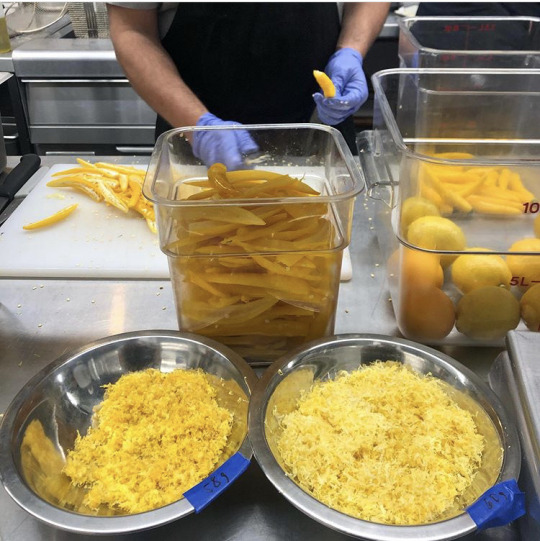
This is an easier fermentation process than pickling because it only requires three ingredients:
Anaheim chilies 80%
Citrus zest 20%
Salt 10% of the total weight.
These ingredients are then allowed to ferment at room temperature for 5 days, then thrown into the fridge where they may be kept up to a few months.
The flavours develop and mellow out as this condiment sits and make for a spicy citrusy punch with anything you choose to dip in it. The fermentation process allows the spice of the chilli to lessen and introduces a welcome bitterness that is counteracted by the fruitiness of citrus zest. I’d compare it to a minionette in its ability to enhance flavour by introducing something bitter and sour. The citrus aroma is the first thing you notice and the tingly spice is what lasts on your palate after you eat.
Feel free to try it at home!
0 notes
Text
Soup of my Childhood.

All images in this post are original images by Hamza Aidrus 2020.
Chicken corn soup!
I sipped chicken corn soup for the first time in a Chinese restaurant in Karachi, Pakistan. I must have been about four or five years old.
I crave this soup every time the temperature drops below five degrees. Pulled chicken, silky egg, sweet bursting kernels of corn, and a hot-sour-spicy broth that clears your sinuses.
I had Monika give it a try in a feeble attempt to have her understand my childhood better, she loves spicy food so she added some chopped jalapeños and more chilli paste to her bowl. She too loves a large bowl of spicy broth in the winter.
This is essentially a boiled whole chicken that we’re extracting the stock from and cooking the chicken at the same time. It’s a pretty simple recipe that I learned through trial and error. I might try using some sort of kombu or shrimp paste in the future to give the soup some more depth, but honestly it’s amazing in its simplicity. Enjoy.
You’ll need:
1 whole chicken
4 litres cold water
3 cloves garlic
2 large eggs
2 table spoons soy sauce
100ml Rice wine or sake
A tablespoon sambal Olek or chilli paste
2 tablespoons vinegar
1 can creamed corn
1 can whole corn kernels
We start with a whole chicken. Untie it if it’s trussed, and by all means, cut out the breast leg or thigh or one of each if you’d like for a separate meal. You can also leave the bird intact for more chicken pieces in your soup.
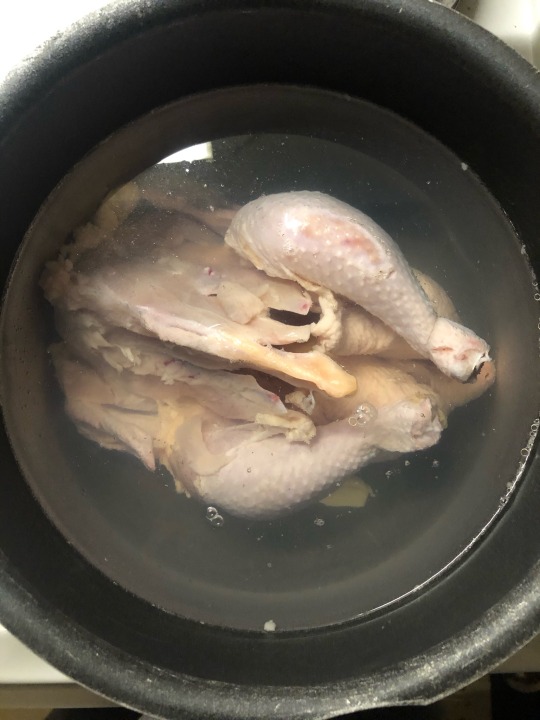
Throw your chicken into a stock pot with one or two cloves of garlic (smashed with the palm of your hand) and cover with cold water. Get it onto the stove and slowly bring to a simmer over medium heat.
Allow your liquid to simmer gently for at least 4 hours, skimming the foam collecting on the surface. Remove the chicken from the broth and place on a plate or tray to cool, and strain the broth into another pot or container.

If you’d like to save some broth, let your broth cool in the fridge overnight with the lid vented allowing steam to escape. You should see gelatinous fat accumulate on top. If you’d like to make the soup right away, pour the strained stock into a deep pot.
Pick the chicken off the bone once it’s cool enough to handle and store in a separate container.

With the chicken stock in a pot, add the pulled chicken and bring to a boil. Add creamed corn, and whole corn, followed by soy sauce, vinegar, rice wine, and chilli paste.

Turn your soup down to a simmer.
Meanwhile, crack two eggs into a bowl and beat the yolks into a single mixture. Pour into the simmering soup and stir. You should have stringy white strands of egg swimming around in your soup. Taste soup for seasoning, and add salt and black pepper to finish.
Feel free to garnish with scallions or chives and sesame oil or more chilli paste.
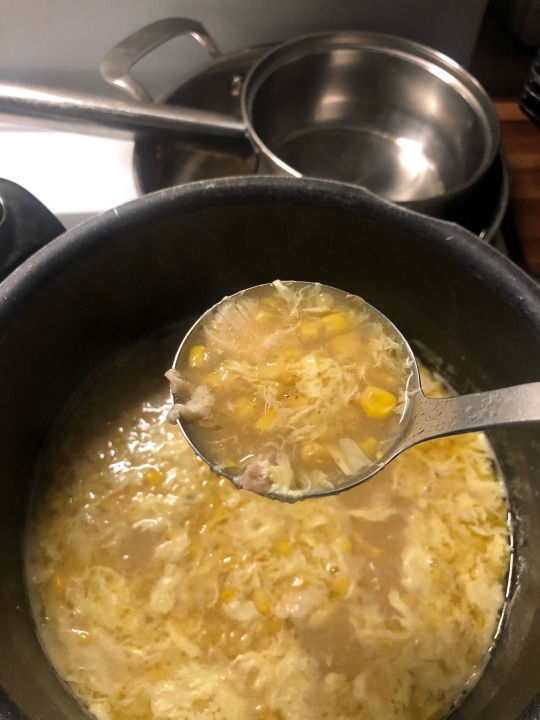
1 note
·
View note
Text
Nutrition
I’ve always been fascinated with the history of food and the staples of different cultures. Why are rice and beans consumed throughout the Caribbean? Why are some foods spicy in certain regions of Italy or India while others are not? The exploration of what different cultures consider “essential foods” in their daily diet, and how these beliefs have shaped their cuisine is what I seek to explore.
As we move toward an industry that favours local and seasonally available products, nutrition plays a key role when deciding what we eat and what we as cooks put on our menus. We turn to the agricultural history of the region we live in to make the best choices in ingredient pairings to create fulfilling and delicious dishes. We have the luxury of knowing what percentage of carbohydrates, sugars, and fats we should consume on a daily basis.
“The human body creates 11 amino acids but must get another nine from food.”
Villines, Zawn, “Top 15 Sources of plant-based protein,” April 12, 2018. <www.medicalnewstoday.com/articles/321474.php>
Every country’s cuisine began by using ingredients that were locally and seasonally available. Although the quote from the website above highlights the amount of amino acids we must get from food, I didn’t find “Medical News Today” to be a credible source of information, let alone a source of information shedding light on how we came to decide on what staple foods are.
Upon further research, I discovered peer reviewed articles on very specific cuisines. In “Food Products as Sources of Protein and Amino Acids—The Case of Poland,” Warsewicz writes about the predominance of sour cabbage and beetroot as staples in the polish diet that became more predominant as preservation techniques were discovered.
Górska-Warsewicz, Hanna et al. “Food Products as Sources of Protein and Amino Acids-The Case of Poland.” Nutrients vol. 10,12 1977. 13 Dec. 2018, doi:10.3390/nu10121977
This ariticle has been cited by educational institutions as well as government institutions and is a peer reviewed source, making it credible.
Before refrigeration, preservation techniques were the key to the survival of a population. I assume this is why food tends to be spicier in warmer climates due to the lack of cold acting as a preservative. This is a topic in nutrition I aim to explore further and do my own research as I seek to learn the nutritive value of pickles, preserves, fermented food, and canned food.
0 notes
Text
Creativity and ego
Cannot go together.
If you free yourself from the comparing and jealous mind,
your creativity opens up endlessly.
—Jeong Kwan
0 notes
Text

JULIA CHILD’S BASIC CRÊPES RECIPE (FOR BOTH SAVOURY AND SWEET), From “The Foodie Baker” (2020)
https://images.app.goo.gl/WotM1zxGP8Q2bjey9
I have immense respect for anyone that cooks with patience.
I grew up around women that treasured a piece of meat and marinated it three days in advance, then cooked it over low heat allowing flavours to develop and the protein to break down into a delicate, tender morsel prized by everyone at the table.
I believe good food comes as a result of preparation and control over heat and time. This is something I strive to perfect.
Growing up in Canada, there’s nothing like a hot stew that blends savoury, spicy, and sweet flavours that have intensified over time. I love ladling a bowl full of bubbling broth and having it fill me with warmth and reassurance.
Home cooking is something I do on a rare day off, but I love to turn an otherwise tough cut of meat or root vegetable into something delicious over time. I’ll often spend the whole day allowing my braise to happen while I clean or kneed a bread dough (I have multiple doughs going at any given point, a golden crust and tender crumb is something I continue to practice).
At the same time, one of my earliest and fondest food memories is of my grandmother cooking pancakes. She was born in Pakistan but lived in Brussels for over a decade. Her version of crepes or pancakes involved a lot of butter. I remember not needing to pour maple syrup over her pancakes, the edges were crispy and the middle was at once fluffy, salty, and sweet.
This combination of textures and flavours is something I’ve held onto since I was a child, and it reminds me that care is really the most important part of churning out a truly great dish.
I hope to share the dishes that I care about though this blog and I hope you find value in my failures and discoveries.
0 notes
Text

I was blissfully ignorant my first shift on line: training during a Friday dinner service. I came from academia, wrote essays and found a desk job.
I had this vision of moving up in the office world and watching the walls of my cubicle expand year after year into what would eventually be a corner office with glass walls, the dust of a freshly opened pack of printer paper getting me excited for an afternoon in front of a screen. How vibrant it would look if I blew my brains out splattering over the clean windexed office windows. I knew the 9-5 wasn’t for me at the time.
I decided to “stage” at a restaurant at the recommendation of a friend I went to school with. I’d never felt anything like the rush of that first service. 10 hours flew by and I was hooked. I wanted to learn everything I could about the industry and about food and cooking.
In a world where our questions are answered instantly, I had to teach myself and practice everything I could. I started with Daniel Boulud’s “Letters to a Young Chef.”
Did I know what braising meant? Did I know how to filet a fish? Could I properly cook an omelette? What does it take to make a loaf of sourdough? How do I make a foam or an ash? How do I truss a chicken? As an English major, I read “Down and Out in Paris and London” by George Orwell (1933). I was fascinated by the restaurant industry and viewed it all as a romantic chaotic symphony. But if I really wanted to make myself valuable in the industry, I’d have to put in the work.
0 notes
Text
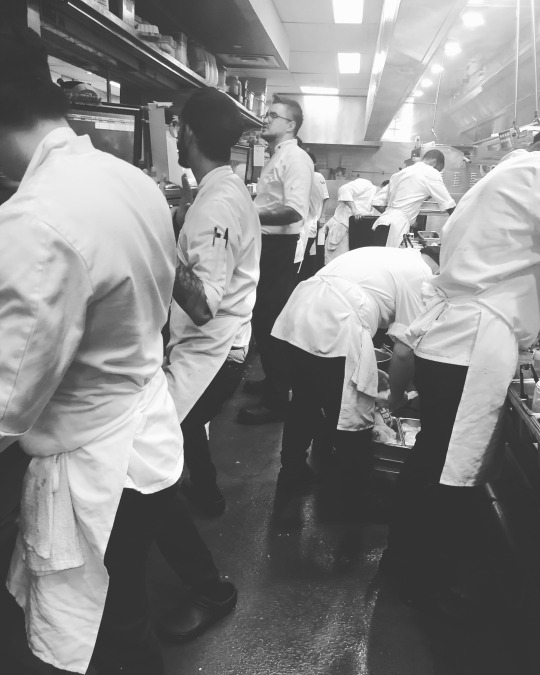
“The line” from Hamza Aidrus (October 2019)
Aidrus, Hamza, Instagram 2019.
https://www.instagram.com/p/B3RHGA5gtFG/?igshid=1ny2alxscv4lo
Working in a kitchen is never glamourous—unless its that close-up shot or slow motion video of the tattooed chef placing the last piece of garnish on a carefully plated dish with a pair of tweezers.
It’s the hard work done by prep and line cooks that allow a plate of food to come together in the first place. Those who have worked in a restaurant know that early mornings, late nights, back pain, high pressure, heat, sharp objects, and failed relationships are apart of daily life. That beautiful finished product takes days of prep before it’s walked out of the kitchen and into the dining room.
instagram
0 notes
Photo

Copyright 2020. Original artwork Hamza Aidrus.
Soigné (swanyay): a French term used in the kitchen to refer to a sleek or well finished dish. It can also mean that the dish in question is for a very important guest. Literally “with care.” I’ve heard chefs ask cooks to “make it swanyay,” and the surgical care that follows makes me smile.
0 notes